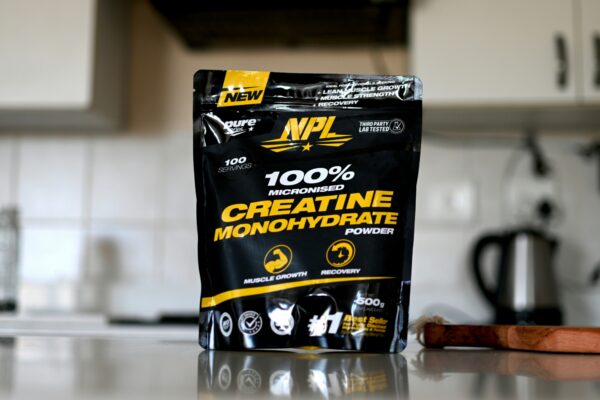Creatine 101: What It Is and Why People Use It
Creatine is one of the most widely used and researched supplements in the fitness and wellness world. Naturally found in muscle cells, creatine helps your body make energy—especially during short bursts of intense activity like lifting weights or sprinting.
Although athletes and gym-goers often take it to improve performance, creatine can benefit anyone looking to support their physical or mental health.
Let's break down what creatine does, how to take it, and when it might work best for you.
Main Benefits of Creatine
Many studies have shown that creatine offers a wide range of health and performance benefits, including:
- Increased muscle strength and power
- Better performance in high-intensity exercise
- Faster recovery after workouts
- Possible improvements in brain function and memory
- A strong safety record for healthy users
In short, creatine can support both your body and mind.
Types of Creatine and How to Take It
Before adding creatine to your routine, it helps to know the different types available and how much you should take.
Most Common Types:
Creatine Monohydrate: This is the most studied, affordable, and effective form. It's the go-to option for most people.

- Other Types: These include creatine hydrochloride, creatine ethyl ester, and buffered creatine. However, research hasn't shown them to work better than monohydrate.
How Much Should You Take?
- Loading Phase (Optional): You can take about 20 grams daily, split into four smaller doses, for five to seven days to quickly fill your muscles with creatine.
- Maintenance Phase: After loading—or if you skip it—stick with 3 to 5 grams daily.
- No Loading? No Problem: If you don't do the loading phase, it'll just take a little longer for your muscles to become fully saturated, but you'll still get the same benefits over time.
Pro Tip: Mix creatine with water, juice, or add it to a smoothie for easy consumption.
Timing: When Should You Take Creatine?
One of the biggest questions people ask is: When is the best time to take creatine?
While timing can have a slight effect, experts agree that consistency is more important than when you take it.
Popular Timing Options:
- Before Exercise: Some people prefer to take it 30 to 60 minutes before a workout.
- After Exercise: Others wait until after their workout, when the body is more likely to absorb nutrients.
- Anytime Works: Research suggests that, overall, taking creatine daily is what really counts—no matter the time of day.

What Does the Science Say?
Some studies show a small benefit to taking creatine after a workout, possibly because your muscles absorb nutrients better when they're low on energy. However, the difference isn't huge.
Boosting Absorption:
- Creatine may be absorbed better when taken with a meal that includes carbs and protein.
- Be sure to drink plenty of water since creatine pulls water into your muscles.
How to Take Creatine on Workout Days and Rest Days
It's important to keep taking creatine every day, whether you're hitting the gym or taking a rest day.
Workout Days:
- Take creatine before or after your workout—choose whichever is easiest to remember.
- Mix it into your protein shake, pre-workout drink, or post-exercise smoothie.
- If you forget, take it later. Missing a day here or there won't ruin your progress, but aim to stay consistent.
Rest Days:
- Take your regular dose at a convenient time—ideally with a meal.
- Pick a time that works for your daily routine and stick with it.
Helpful Habits:
- Set a daily reminder on your phone.
- Keep your creatine somewhere visible, like near your water bottle or in the kitchen.
- Pair it with daily habits like brushing your teeth or making breakfast.

Clearing Up Common Myths About Creatine
There's a lot of confusion about creatine. Let's set the record straight with science-based answers.
Is Creatine Safe for Long-Term Use?
Yes. Creatine is one of the safest supplements available, with decades of research supporting its use.
Do You Need to Take Breaks From Creatine?
No. You can take creatine every day for months or even years without needing to "cycle" on and off.
Will Creatine Make You Gain Fat or Look Puffy?
Creatine can make your muscles hold more water, which might show up as a small weight gain. This is not fat—it's just your muscles becoming fuller and more hydrated.
Do You Need Sugar With Creatine?
While carbs can help your body absorb creatine, they're not required. You'll still benefit from taking it with just water or a balanced meal.
Is Creatine Only for Bodybuilders or Athletes?
Not at all! Creatine can support energy, recovery, and even brain health—making it a helpful supplement for people of all activity levels.
Keep It Simple and Stay Consistent
The most important thing about taking creatine is sticking with it. While taking it after a workout might offer a slight boost in absorption, what matters most is taking it daily.
Quick Summary:
- Stick with 3–5 grams per day.
- Don't stress about timing—just be consistent.
- Creatine monohydrate is effective and affordable.
- Mix with water, juice, or a meal.
- It's safe for most people and not just for athletes.
You can support physical performance and overall wellness by building creatine into your daily routine. As with any supplement, it's a good idea to check with a healthcare professional before starting—especially if you have a medical condition.



